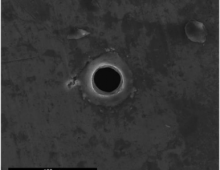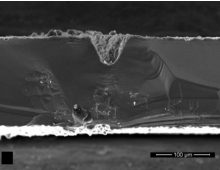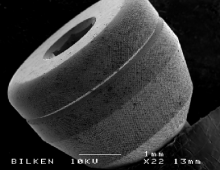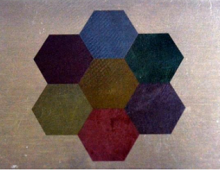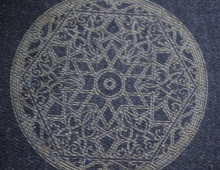Research
My research focuses on the development of novel fiber lasers, both soft and hard glass, for various industrial and scientific applications. The main topics in which I am engaged are listed below. Please visit the Academic section to view my publications, conference proceedings, book chapters, patents and theses.

A fiber laser cavity
The fiber laser sources are crucial for various applications such as material processing, medicine, molecular spectroscopy, detection, defense, and security. On the other hand, the development of high-power mid-IR sources is necessary to meet the requirements of many applications. The techniques to allow for mid-IR light generation vary, so new technologies for the development of such sources are crucial.
Fiber laser technology, one of the tools for generating mid-IR coherent signals, especially between 2 to 5 µm, has made excellent progress over the last ten years in terms of compactness, reliability, high beam quality, and output power. I have been working on the development of a new generation of high-power mid-infrared fluoride fiber-based laser sources. The objective of this work is to achieve high average power and slope efficiency, either in continuous wave or pulsed regime, from a laser cavity or amplifier operating around a wavelength of 3 µm. The high-power fiber laser development near 3 µm is a considerably challenging process due to the weak mechanical and thermal properties of fluoride fibers and the limitations related to the development of laser components based on fluoride glass.
Within the scope of my PhD project, 3 µm-class fluoride fiber laser sources, each representing at least one record output parameter in their own category, have been investigated. First, the highest optical-to-optical efficiency (50%) at 2.8 µm was achieved from a diode-pumped fiber laser cavity by cascaded transitions of 2.8 µm and 1.6 µm in a low-doped erbium fluoride fiber (Optica, 2017). Then, active media based on erbium and holmium/praseodymium zirconium fluoride fibers seeded by a sub-ns solid-state laser enabled the achievement of the highest pulse energy (122 µJ) and average power (2.45 W) from a picosecond fiber laser amplifier operating near 3 µm (Optics Letters, 2018). Lastly, a world-record output power was obtained from a splice-less fluoride fiber laser cavity operating near 3 µm (Optics Letters, 2018). In my postdoctoral researcher experience, we further developed such a cavity and achieved a 1 mJ level of pulse energy at 2850 nm. This is another highest pulse energy record achieved from a fiber laser operating near 3 µm (Optics Letters, 2021). This work has been chosen for inclusion in Spotlight on Optics in Optica.
The evolution of fluoride fiber laser technology considerably depends on the advances in optical components working in the mid-IR spectral region. The components used in mid-IR fiber lasers have progressed in the last 15 years, leading to stable, long-term operation of high-power fiber laser systems operating around 3 µm. Despite this, fluoride fiber-based laser technology still lacks stable, high-power components compared to silica-based technology and has been advancing rather slowly due to the poor thermo-mechanical properties of fluoride glasses.
The main components for a 3 µm fiber laser system can be listed as follows: the fluoride-based fiber, the fiber Bragg gratings (FBGs), the pump sources, the splices, pump combiners, and the endcaps. My research interests in component development are mainly soft-glass fiber splices and the fabrication of endcaps. Experience in splicing soft-glass fibers has enabled compact laser architectures and higher transmission efficiency with reduced parasitic lasing in fluoride fiber laser systems (Mid-Infrared Fiber Photonics, 2022). Endcaps are critical components to suppress OH migration, which limits output power and can lead to catastrophic failures. In 2019, we investigated the resistance to OH diffusion of fluoride and oxide endcaps manufactured from ZrF3, AlF3, GeO2, SiO2, and Al2O3 fibers to address this issue. To overcome this problem, we proposed a novel method to completely suppress OH diffusion, which consists of sputtering a nanoscopic diffusion barrier film made of silicon nitride (Si3N4 on the output face of the endcap (Optics Express, 2019). The effectiveness of the approach is validated on Al2O3, ZrF4, and AlF3 endcaps, which show no sign of degradation after being used for more than 100 hours at the output of a 3 µm laser.
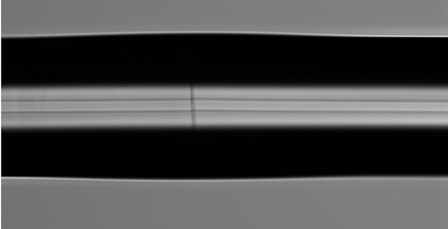
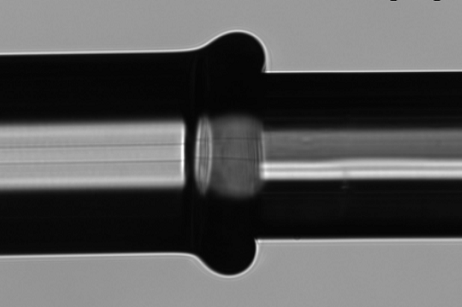

Ytterbium-doped fiber lasers (YDFLs) working in the near-infrared (NIR) spectral window are popular in many industrial applications, such as marking, cutting, micromachining, and scribing, thanks to their capability for efficient single-mode high-power operation. Silica-based glasses are robust and easy to cool compared to fluoride-based glasses, so much interest in the development of high-power silica-based fiber laser systems has arisen recently worldwide. I worked for FiberLAST Inc., an exclusive industrial company developing its own proprietary laser design and manufacturing advanced fiber lasers. During my 5 years of experience in the company, I participated in many different award-winning fiber laser projects as a research and development engineer. The outputs of most projects have turned into industrial laser products, such as laser marking and cutting systems.
My master’s thesis was based on the development of a laser amplifier for materials processing applications. In this study, a nearly diffraction-limited ytterbium-doped all-fiber amplifier with 60 W average power and more than 20 kW peak power at 1 µm was developed, and its potential for processing different material types was investigated. This master-oscillator power amplifier (MOPA) system architecture is composed of pulses produced by an electronically pumped diode and amplified by a series of fiber amplifiers. In contrast with Q-switch lasers, the MOPA architecture allows us to adjust pulse duration, repetition rate, and output power independently, which is crucial to extending the ability of the laser to process a variety of materials. After the development of the laser amplifier and certification of its materials processing capability, an industrial prototype was configured, taking cost-efficiency into account.
To demonstrate the efficiency and ability to process various kinds of materials with the developed laser amplifier system, a multitude of processing applications such as micro drilling, solar cell edge isolation, deep engraving, and color marking were tested on metal, semiconductor, and insulator surfaces. The results are discussed in relation to various system operation parameters (METU, 2014). The materials processing demonstrations are shown in the pictures below.
